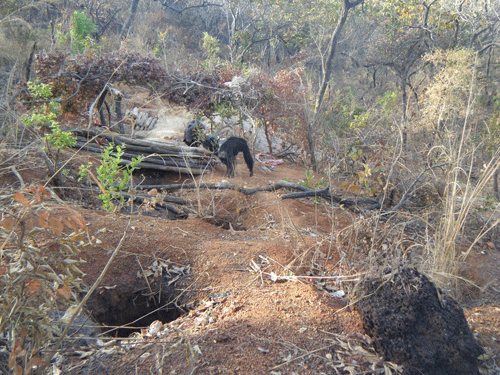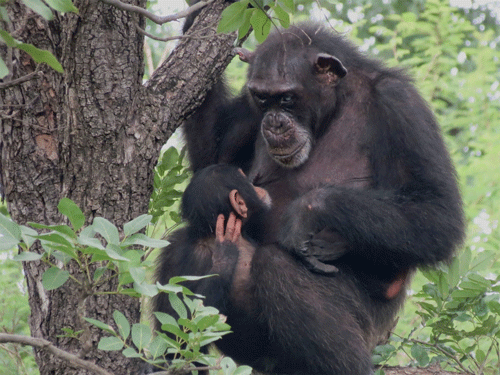Chimpanzees in the Land of Gold
|
|
West African Chimpanzees. By Kelly Boyer Ontl. |
By Kelly Boyer Ontl
Visiting Assistant Professor Michigan Technological University Falémé Chimpanzee Conservation
Gold prices have nearly quadrupled over the past seven years and the ongoing global gold rush has drawn much attention to West Africa and it’s expanding gold mining industries. The biodiversity impacts of large and small-scale gold mining are varied, and this study deals with the impacts of artisanal small-scale gold mining (ASGM) on the critically endangered West African savanna chimpanzee (Pan troglodytes verus).
The tradition of gold mining in West Africa has centuries-long history, mostly as ASGM, a labor-intensive mining method that uses rudimentary tools and often lacks safety measures or environmental protections. Mines are often shallow deposits reached by hand-dug shafts with a team of workers that include rope pullers, diggers, and shaft owners (Persaud et al., 2017). Once the gold-laden rock is retrieved, it is processed by people who crush the rock, either by hand or machine, and then wash it with mercury or simply water. ASGM accounts for approximately 330 tons of gold each year, or 12% of the annual global production (Telmer and Veiga, 2009), and contributes 37% of the world’s annual atmospheric mercury emissions (UNEP, 2013).
Artisanal gold mining takes place in nearly all the West African chimpanzee range countries of Senegal, Mali, Guinea, Ghana, Liberia, Sierra Leone and Cote d’Ivoire, excluding only Guinea Bissau where gold deposits are minimal. Environmental impacts associated with artisanal gold mining include mercury pollution, sanitation issues, open and abandoned pits, and deforestation, among others. Research to quantify the impacts of ASGM on great apes is lacking, and this study tries to fill this void to report findings on changes in chimpanzee behavior and habitat use from an ASGM site at the Fongoli field site in the Kedougou region of Senegal (Boyer Ontl, 2017).
Ten years of chimpanzee observational data was analyzed to assess behavior impacts from the Fongoli Savanna Chimpanzee Project (FSCP) database (1160 days of observation and over 10,300 contact hours). Using global information systems, chimpanzee and mining locations for the 10-year period were projected into ArcMap 10.4.1 (Environmental Systems Research Institute, Redlands, CA). Using ArcMap, the frequency by which chimpanzees visited the ASGM site (defined as the mined area and a 10-meter buffer surrounding the mine) was quantified. The habitat types they were located prior to the onset of mining (2005-2007), during early phases of mining (2008-2012), and in the latest and most intensive phase of mining (2013-2014) was also ascertained.
 |
|
Chimpanzee investigating an artisanal mining site at Fongoli, Senegal. Photo credit: Jill D. Pruetz. |
Chimpanzees are generally fearful of people. Based on the landscape of fear concepts, it was predicted that the Fongoli chimpanzees would adjust their time allocation and behaviors at the ASGM site as mining increased. It was expected the chimpanzees would spend less time at the mine, as well as less time for resting, feeding, drinking, and socializing (stationary behaviors) at or near the mine. On the contrary, the chimpanzees increased their use of the mined area, as mining progressed, both in stationary behaviors and traveling and moving (active behaviors), relative to their use of the area prior to mining. The chimpanzees were found to feed, rest, and socialize alongside of the mining area, with people working and moving less than 50 meters from the apes.
When including variables for habitat type (i.e. anthropic mining area, savanna/grassland, and woodland/forest) and the presence/absence of miners, an interaction that revealed an avoidance of human disturbed areas in the presence of people was observed. A Pearson’s chi-square test showed a significant difference between chimpanzee use of the mined area on miners’ workdays versus their days off [X2(1, N=222) = 57.86, p = 2.82e-14]. The chimpanzees used the anthropic and savanna areas significantly more when miners were absent [X2(1, N=44) =18.29, p = 1.90e-05 and X2(1, N=49) = 7.053, p = 0.008, respectively], and forested and woodland areas were used more when miners were present [X2(1, N=35) = 20.51, p = 5.93e-06].
A premise that chimpanzees would avoid all areas of mining activity was negated. Instead, it was observed the apes used mined areas more, particularly on days when miners were absent. When the chimpanzees were near people at the ASGM site, they inspected materials left by the miners and drank water from mining pits. The chimpanzees avoided the site when mining expanded and increased in intensity in 2013 and 2014.
The chimpanzees’ continued use of ASGM sites and their behavioral adjustments to the presence of miners suggests plasticity in chimpanzee behavior to cope with mining disturbances. Unfortunately, many of the risks associated with ASGM sites are not easily recognizable to chimpanzees, potentially resulting in an ecological trap. A lack of sanitation can impact chimpanzees that drink from polluted water sources. Additionally, lack of restoration and reclamation of mined areas lead to open and abandoned pits that can become overgrown with vegetation, thereby causing pit falls and trap hazards to the apes.
At the time of writing, gold prices remain elevated and it seems unlikely they would drop below the pre-global recession levels. ASGM continues to expand in southeastern Senegal and across the world. West African chimpanzees, recently listed as a critically endangered subspecies, are particularly vulnerable to the increasing threat of ASGM disturbance, as gold mining is widespread in the region and habitat fragmentation and depletion continue unabated. The analysis from this study may also be extended to other great apes in central Africa where resource extraction is also prevalent. This study highlights the need for further research on the health impacts of ASGM and other extractive industries on great apes.
Literature Cited
Persaud, A. W., Telmer, K. H., Costa, M., & Moore, M. L. (2017). Artisanal and Small-Scale Gold Mining in Senegal: Livelihoods, Customary Authority, and Formalization. Society & Natural Resources, 1-14.
Telmer, K. H., & Veiga, M. M. (2009). World emissions of mercury from artisanal and small-scale gold mining. In Mercury fate and transport in the global atmosphere (pp. 131-172). Springer US.
UNEP. (2013) Global Mercury Assessment 2013: Sources, Emissions, Releases and Environmental Transport. UNEP Chemicals Branch, Geneva, Switzerland.
Boyer Ontl, K.M. (2017) PhD Dissertation. Iowa State University. Chimpanzees in the Island of Gold: Impacts of artisanal small-scale gold mining on chimpanzees (Pan troglodytes verus) in Fongoli, Senegal
